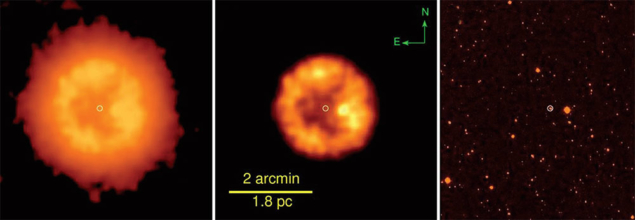
A never-before-seen object with a cataclysmic past has been spotted in the constellation Cassiopeia, about 10,000 light years away. The star-like object has a temperature of 200,000 K, shines 40,000 times brighter than the Sun and is ejecting matter with velocities up to 16,000 km s–1. In combination with the chemical composition of the surrounding nebula, the data indicate that it is the result of the merger of two dead stars.
Astronomers from the University of Bonn and Moscow detected the unusual object while searching for circumstellar nebulae in data from NASA’s Wide-Field Infrared Survey Explorer satellite. Memorably named J005311, and measuring about five light years across, it barely emits any optical light and radiates almost exclusively in the infrared. Additionally, the matter it emits consists mostly of oxygen and does not have any signs of hydrogen or helium, the two most abundant materials in the universe. All this makes it unlike a normal massive star and more in line with a white dwarf.
White dwarfs are “dead stars” that remain when typical stars have used up all of their hydrogen and helium fuel, at which point the oxygen- and carbon-rich star collapses into itself to form a high-mass Earth-sized object. The white dwarf is kept from further collapse into a neutron star only by the electron degeneracy pressure of the elements in its core, and its temperature is too low to enable further fusion. However, if the mass of the white dwarf increases, for example if it accretes matter from a nearby companion star, it can become hot enough to restart the fusion of carbon into heavier elements. This process is so violent that the radiation pressure it produces blows the star apart. Such “type 1A” supernovae are observed frequently and, since they are unleashed when a white dwarf reaches a very specific mass, they have a standard brightness that can be used to measure cosmic distances.
Despite having the chemical signature of a white dwarf, such an object cannot possibly burn as bright as J005311. By comparing the characteristics of J005311 with models of what happens when two white dwarfs merge, however, the explanation falls into place. As two white dwarfs, likely produced billions of years ago, orbited one another they slowly lost momentum through the emission of gravitational waves. Over time, the objects came so close to each other that they merged. This would commonly be expected to produce a type 1A supernova, but there are also models in which carbon is ignited in a more subtle way during the merging process, allowing it to start fusing without blowing the newly formed object apart. J005311’s detection appears to indicate that those models are correct, marking the first observation of a white-dwarf merger.
The rejuvenated star is, however, not expected to live for long. Based on the models it will burn through its remaining fuel within 10,000 years or so, forming a core of iron that is set to collapse into a neutron star through a violent event accompanied by a flash of neutrinos and possibly a gamma-ray burst. Using the speed of the ejected material and the distance it has reached from the star by now, it can be calculated that the merger took place about 16,000 years ago, meaning that its final collapse is not far away.
Further reading
V Gvaramadze et al. 2019 Nature 569 684.





